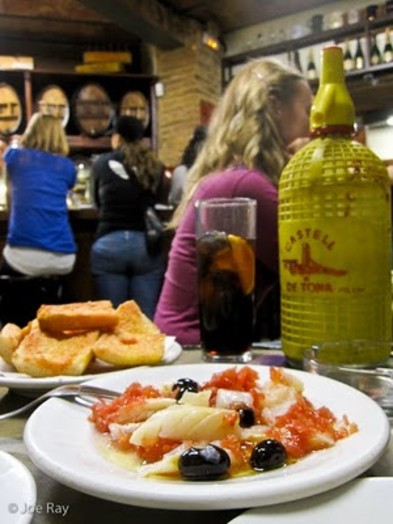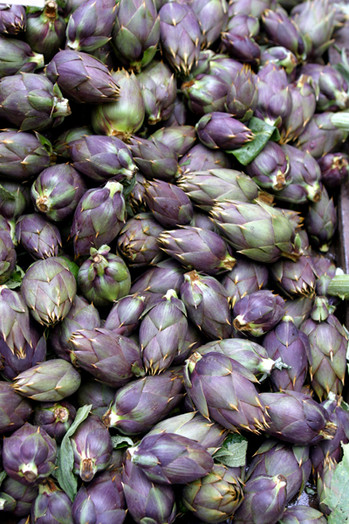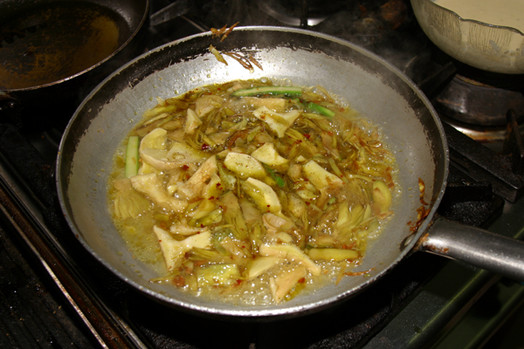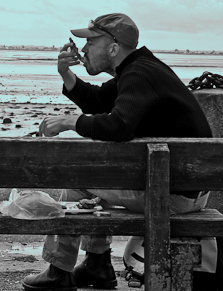Joe Ray
Food & Travel / Words & Photos

Monday, December 28, 2009
Who Needs Teeth In A Half-Cellar of Goodness?
I reconnect with the city a few steps below street level.
We share a little plate of artichokes hearts that are drizzled with olive oil and spritzed with fleur de sel. They’re so tender, you don’t need teeth.
There’s also a little wheel of oil-bathed goat cheese that’s somehow has the wonderful tang of cheddar. We get a bacalao-tomato dish with olives and a separate plate of olives that I’m supposed to share. Oops.
We wipe up our fingers with the ubiquitous useless napkins and wash it down with vermouth and seltzer water.
It’s good to be home.
Count on about 10-20€
La Bodegueta – MAP

Rambla de Catalunya 100

Barcelona

+34 932 154 894


Tuesday, April 24, 2007
Winking At The Matriarch
A calm chef is a rare bird, usually signifying that his restaurant is about to fold or that he’s depressed. In Peppino Carollo’s case, however, his calm comes from successfully crossing a bridge from traditional Sicilian cuisine to something that is his own.
“I don’t like making carbonara. Pannacotta? I can’t do it,” he said referring to heavy Italian classics.
Here in Sicily, tradition often comes from harder times like making it through a famine or feeding a town surrounded by an attacking enemy.
Today, matriarchs have it easier but still need to fill the bellies of their ilk at seemingly endless Sunday meals and restaurant food here can be heavy enough that you understand why things like vomitoriums used to be installed around the island.
While Carollo’s cooking is clearly Sicilian, a meal at his Castelbuono restaurant, Nangalarruni, leaves you with that healthy, end-of-a-sushi-meal feeling.
“It makes me happy to create new sensations,” he said. “I like to let the old recipes remind me of the past…I think of grandma when I cook, but I do my own stuff.”
Right now, this means concentrating on artichokes.
For Carollo, the keys are three closely tied concepts: seasonality, simplicity and perfect products. There’s also the pleasantly curious addition of economy.
“In November (when they are hard to get), an artichoke costs one euro (about $1.30). Now, they’re cheap. This is the time to get them,” he said, helping to explain why his highly-respected establishment is also known as a bargain.
He demonstrated this with three plates highlighting artichokes – a carpaccio with cheese and oranges, a batter-dipped classic called carciofi in pastella and in a veggie sauce to accompany fresh tagliatelle. None of these dishes took more than 15 minutes to prepare.
For the tagliatelle, he put a large saucepan over medium-high flame, poured a thick coat of olive oil onto the bottom and added two peeled garlic cloves that he had lightly crushed with his hand. He cut the tops off of a couple of artichokes, pinched off several outer layers of leaves, halved them lengthwise and cored with a pen knife called a Siciliano. He sliced the halves into skinny strips and tossed them in the pan, giving it a flip or two that painted them the rich green of the olive oil. While that cooked, he peeled and halved a couple asparagus tips, added those, then sliced a few handfuls of local mushrooms and tossed them on top.
“They are all ingredients that only need a little cooking time.” he said. “You want to feel their al dente – their crunch.”
He removed the garlic, added a few small ladles of a light vegetable broth, along with some salt, pepper and red pepper flakes and let the whole thing bubble away while he tossed the fresh tagliatelle into boiling water.
“The tagliatelle gets one minute to cook. Just one,” he said, gently brushing me out of the way before he pulled it out and added it to the saucepan with the vegetable sauce.
“It’s very quick cooking, very healthy… buono,” he said plating the pasta and making that ‘lips kissing fingertips’ gesture before adding a few sprigs of wild fennel and a final drizzle of olive oil, over the top, the warmth of the dish releasing the aroma of the final additions.
Looking like he spent a lot of time watching his grandmothers cook as he grew up, there’s also an impressive practicality to the way he cooks. He holds the artichokes by the stem as he dips them into a batter before frying to reduce mess, he smells the olive oil every time he uses it and the closest thing he seems to have to measuring cups are his hands.
Though he’s clearly pushing things in a new direction, his pastella turns out to be almost identical to one I had prepared by a grandmother at a family dinner the day before.
“We don’t do a lot of fried stuff,” he said, but hunched his shoulders as if to say that this was one part of tradition that was best left untouched.
This is Joe Ray reporting from the Motherland.
